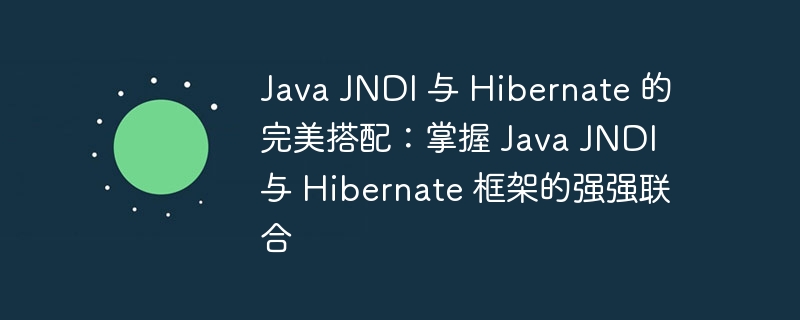

php editor Zimo has launched a new article "The Perfect Match of Java JNDI and Hibernate", which deeply discusses the joint application of Java JNDI and Hibernate framework, and provides a practical guide for Java developers. . By mastering the combination of the two, developers can better build stable and efficient Java applications, improving development efficiency and code quality. This article will introduce the concepts, principles and practical application skills of Java JNDI and Hibernate in detail to help readers better understand and use this powerful combination.
Integrating Java JNDI with the Hibernate framework can provide the following advantages to Javadevelopers:
In order to integrate Java JNDI with the Hibernate framework, the following steps are required:
org.hibernate hibernate-core 5.6.10.Final javax.naming javax.naming 1.0
InitialContext context = new InitialContext();
SessionFactory sessionFactory = (SessionFactory) context.lookup("java:comp/env/hibernate/sessionFactory");
Session session = sessionFactory.openSession();
Transaction transaction = session.beginTransaction(); Person person = new Person("John", "Doe"); session.save(person); transaction.commit();
Through the above steps, you can integrate Java JNDI with the Hibernate framework and use JNDI to find Hibernate SessionFactory instances.
Demo code:
package com.example.hibernate; import javax.naming.InitialContext; import javax.naming.NamingException; import org.hibernate.SessionFactory; public class HibernateUtil { private static SessionFactory sessionFactory; public static SessionFactory getSessionFactory() throws NamingException { if (sessionFactory == null) { InitialContext context = new InitialContext(); sessionFactory = (SessionFactory) context.lookup("java:comp/env/hibernate/sessionFactory"); } return sessionFactory; } }
package com.example.hibernate; import org.hibernate.Session; import org.hibernate.SessionFactory; public class PersonDao { private SessionFactory sessionFactory; public PersonDao(SessionFactory sessionFactory) { this.sessionFactory = sessionFactory; } public void savePerson(Person person) { Session session = sessionFactory.openSession(); Transaction transaction = session.beginTransaction(); session.save(person); transaction.commit(); session.close(); } }
package com.example.hibernate; import org.springframework.context.annotation.Bean; import org.springframework.context.annotation.Configuration; @Configuration public class HibernateConfig { @Bean public SessionFactory sessionFactory() { InitialContext context = new InitialContext(); return (SessionFactory) context.lookup("java:comp/env/hibernate/sessionFactory"); } @Bean public PersonDao personDao(SessionFactory sessionFactory) { return new PersonDao(sessionFactory); } }
Summarize:
The integration of Java JNDI with the Hibernate framework provides Java developers with a powerful data access solution. This article details how to integrate Java JNDI with the Hibernate framework and how to use JNDI to find Hibernate SessionFactory instances.
The above is the detailed content of The perfect match between Java JNDI and Hibernate: Master the powerful combination of Java JNDI and Hibernate framework. For more information, please follow other related articles on the PHP Chinese website!




